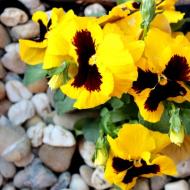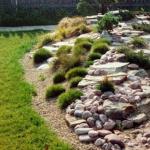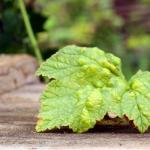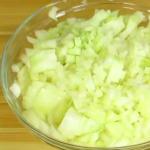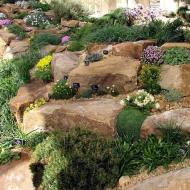
Water accompaniment on the hill
Alpine slide is one of the favorite elements of landscape design, both for owners of garden plots and for professional designers. But, at the same time, it is also one of the most difficult. To independently make a rocky hill in your garden, you must adhere to a sequence of fairly clear rules.
The algorithm for creating an alpine slide:
1. Choosing a place under the sun.
2. Decide on the size and shape.
3. Selection and purchase of a stone.
4. Drawing the contour of the rock garden on the ground.
5. Removal of the top fertile layer of the earth.
6. Preparation of the soil mixture.
7. The device of the drainage system.
8. Vertical planning of rock garden.
9. Water support on the hill.
10. Selection and planting of plants.
Choosing a place in the sun
A fragment of a mountain landscape is best placed on an elevated, well-lit area. In this case, the owners of a hilly area or slope are more fortunate. The most attractive rock garden will look against the backdrop of a lawn away from tall trees that can project their shadow onto it.
Since our rock garden is a slide, it will have slopes oriented to different parts of the world. The rock garden project should be designed in such a way that the observer mostly surveys its southern and southeastern sides. These slopes are made more gentle than the north and northeast.
Decide on the size and shape of the slide
No matter how you imagine an alpine hill in your imagination, it should harmoniously fit into the overall style of the garden and not look like a pile of stones, because of which the house modestly looks out.
There are clear rules for determining the size of a rock garden for a specific area of the site. On a plot of 6 - 8 acres, an alpine slide can occupy an area of up to 5 - 10 m 2 and reach a height of 60 cm. The minimum size of the slide is 1.5 x 2.5 m. numbers. The maximum height of an alpine slide with an area of more than 40 m 2 can be up to 1.5 m.
Choosing and buying a stone
The size and number of stones are chosen according to the size of the rock garden. For a rock garden with a size of 1.5 x 2.5 m and a height of 0.5 m, about 1 ton of stone will be required.
To create stone compositions, stones of the same breed are used, mostly local, which is the easiest to get and which will be most harmoniously combined with the area.
Stones and plants should emphasize the beauty of each other, therefore, in order for the final composition to correspond exactly to your ideas of beauty, choose the stones yourself and be present when they are loaded and unloaded.
Do not take stones that are chipped with unnaturally sharp edges or, conversely, perfectly smooth river ones. The best option would be a moss-covered stone that you accidentally found in the forest - and you don’t need to pay, and nature itself has already worked on the design.
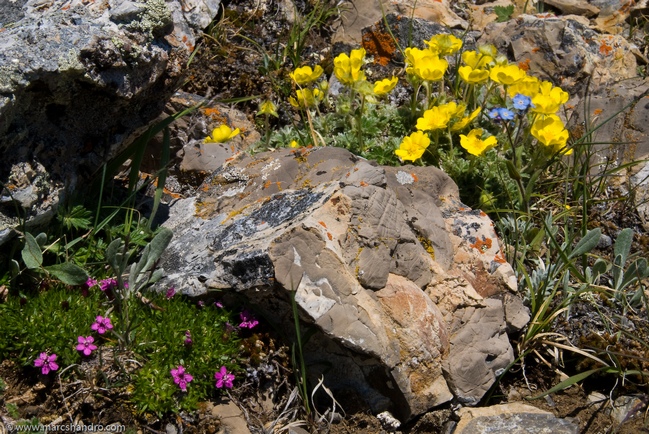
Drawing the contour of the rock garden on the ground
On the site, which is intended for the construction of a rock garden, we draw the contours of the future structure. This stage at first glance seems simple, but its implementation is the basis of the entire process of building a slide. Having drawn the outline of the structure (using a rope, for example), view the future composition from all viewpoints, you may need to adjust the boundaries and location on the ground.
Removal of the top fertile layer of the earth
It is important to carefully remove the top fertile layer of the earth, which, after sieving, is added to the composition of the substrate to fill the space between the stones on the hill. The top layer of soil is removed to a depth of 20 - 30 cm over the entire area of the future rock garden. It is advisable to carry out such work when the earth is dry enough to be sieved. If the site is heavily overgrown with cereal weeds, herbicides must be applied, otherwise the seeds remaining in the soil will germinate on a hill with dense turf.
Soil preparation
The substrate for filling the space between the stones on the alpine hill should be sufficiently nutritious and moderately moist. Prepare it yourself from 1/3 soddy land, 1/3 peat or compost, 1/3 coarse sand, you can also add perlite. If the land on the site is fertile enough, then the top layer, which was removed to prepare the pit for drainage, is used to prepare the soil mixture. Many gardeners recommend adding fertilizer to the composition of the substrate to increase soil fertility. But this is by no means applicable to alpine slides. Plants on such soil are strongly elongated, green mass predominates in their appearance, and flowering becomes less abundant, in addition, aggressive ground covers grow rapidly, covering the stone, as a result of which the whole meaning of the rocky garden is lost.
The soil mixture is poured onto the hill at the same time as the stones are laid, tamping it a little. At the final stage of work, the resulting slide must be well watered, and then the resulting recesses should be corrected.
Drainage system device
Creating a drainage system for an alpine slide is not always required. Drainage is necessary in areas with loamy or clay soil, as well as in flat areas with a high groundwater table.
For drainage, crushed stone or other small stones are used, which are poured in a layer of 0.1 - 0.3 m. The drainage layer is poured unevenly - where the elevation of the hill is planned, the layer will be thicker.
Sand is poured over the rocky layer with a layer of 0.1 m. At the same time, in places of future hills, it is thicker.
The next stage in the arrangement of the slide will be abundant watering, after which the drainage will thicken a little, and all the shortcomings of the work done will appear. But at this stage, everything is fixable.
Vertical planning of rock garden
The most crucial stage in the construction of the slide is the installation and grouping of stones. With the help of stones create three-dimensional compositions. Moreover, each individual group should differ from the neighboring one in size, ratio of sections and color. When imitating a mountain landscape, avoid regular geometric shapes.
For vertical planning of the rock garden, the largest stone is laid first. Its location should be shifted from the center to the east side. Then smaller stones are laid, adhering to the rule - the closer to the border of the hill, the smaller the stone should be. Some groups of stones are laid tightly to each other, we leave gaps between others, avoiding symmetry as much as possible. When laying the stone, it is necessary to leave soil pockets for planting plants.
The stones should not swing, therefore, small depressions are prepared under their base for at least 1/3 of the height of the stone itself. If necessary, add soil or small stones.
If you are the owner of an absolutely flat area, then you will need imported land at the rate of 0.5 - 0.7 t / m 2.

Water accompaniment on the hill
The combination of water, stone and plants in an alpine slide is the most successful option for your project. You can decorate a rocky hill with a murmuring stream, which will flow from stone to stone to a reservoir located on the south side at its foot.
Selecting and planting plants
Planting begins after several heavy waterings, when the earth settles and the resulting recesses are filled up.
The most light-loving plants are planted on the south or southeast side of the hill. Large plants are planted near large stones, small plants - near small ones, avoiding close placement of plants on a hill. Ground cover plants that grow rapidly are planted in 3 - 5 pieces / m 2. Cushion perennials are placed at 8 - 12 pieces / m 2. Dwarf trees and shrubs are planted separately or in small groups, so as to emphasize the asymmetry of the hill. In no case should trees be planted in the center of a stone placer or on its top.
After planting, the soil is mulched by screening out the stone that was used in the construction of the rock garden.

10 mistakes when building an alpine slide:
1. The device of a rock garden on a site with a close occurrence of groundwater without drainage.
2. Placing a rock garden against the backdrop of outbuildings.
3. Unstable placement of stones.
4. The use of several different stony rocks in one composition.
5. Use of fragments of concrete slabs.
6. Use of rich soils and fertilizers that increase fertility as a substrate.
7. Compliance with symmetry when laying stones and planting plants.
8. Ignoring the watering of the slide after the drainage device and at the final stage.
9. Planting ground covers that grow rapidly next to small rosettes or very rare plants.
10. Planting annual plants.
Natalia Vysotskaya, landscape designer, Ph.D. -X. Sciences.
And to make your idea of an ideal alpine slide more holistic, we suggest you admire the photo gallery of the most interesting (in our opinion) rock gardens and rocky gardens.
We also remind you that in our store you can purchase from private collections. On sale there are always seeds of gentians, carnations, saxifrage, primroses, penstemons, bluebells and other mountain (and not only!) species of plants. The range is constantly updated.






